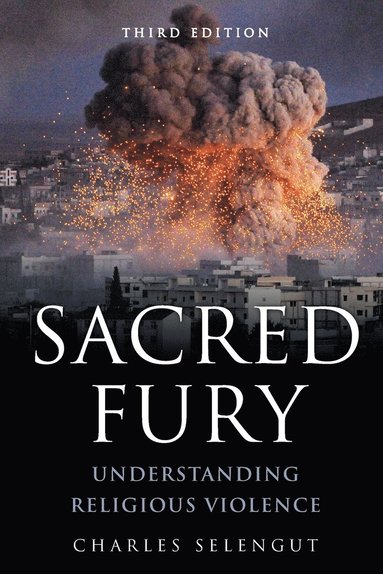
- Format
- Häftad (Paperback / softback)
- Språk
- Engelska
- Antal sidor
- 250
- Utgivningsdatum
- 2017-01-12
- Upplaga
- Third Edition
- Förlag
- Rowman & Littlefield
- Illustrationer
- Black & white illustrations
- Dimensioner
- 229 x 150 x 18 mm
- Vikt
- Antal komponenter
- 1
- Komponenter
- ,
- ISBN
- 9781442276840
- 363 g
Sacred Fury
Understanding Religious Violence
- Skickas från oss inom 7-10 vardagar.
- Fri frakt över 249 kr för privatkunder i Sverige.
Passar bra ihop
De som köpt den här boken har ofta också köpt Don't Believe Everything You Think av Joseph Nguyen (häftad).
Köp båda 2 för 729 krKundrecensioner
Fler böcker av Charles Selengut
-
Our Promised Land
Charles Selengut
Our Promised Land takes readers inside radical Israeli settlements to explore how they were formed, what the people in them believe, and their role in the Middle East today. Charles Selengut analyzes the emergence of the radical Israeli Messianic ...
Recensioner i media
In this newly revised and expanded edition of a book first published 14 years ago, Selengut continues and expands the increasingly needed conversation on religion and violence. Praise for this new edition by Mark Juergensmeyer, arguably the expert on the subject, is testimony to its worth. In the introduction, Selengut sets the scene by noting the duality of good and evil in religious traditions, and in the book's five chapters he looks at the subject through the lenses of scripture, psychology, apocalypse, civilization, and suffering. The first chapter highlights the importance of acknowledging religious realities and builds up to the second and strongest chapter, which emphasizes the central role psychology plays in religious violence. The chapter on apocalypticism looks at exaggerated but repressed religious sentiments and leads to a chapter on the grey area between religion and politics. The last chapterdelves into sexual violence and gives a nod to the gendered component of violence in religion. Selengut provides a holistic, up-to-date examination of religion and violence, a deadly combination. Summing Up: Recommended. Lower- and upper-division undergraduates; general readers. * CHOICE * In an effort to reflect recent events, Sacred Fury has been updated with approximately fifteen pages of new material (e.g., the rise of ISIS, the activities of homegrown terrorists, violence against Rohingya Muslims). There is no question that Selenguts framework is far-reaching and disciplinarily capacious. [T]he text is a useful taxonomy of research on the topic. It fruitfully highlights the multi-dimensional nature of the relationship between religion and violence, and compels the reader to consider the reality that a single action the decision to engage in an act of violence for a religious reasonshould be considered through a variety of lenses. The most recent edition also deserves credit for correcting a problematic emphasis on Judaism, Christianity, and Islam that was evident in previous versions. The newest edition, by contrast, reflects not only a linguistic shift but also a shift in content: as one example, the first page now explicitly mentions Hinduism and Buddhism and new material on Hindu/Buddhist violence has been added to the first chapter. The book remains important and worthwhile because it offers one of only a few interdisciplinary analyses of the relationship between religion and violence. * Reading Religion * In this revised and expanded edition of Sacred Fury, Selengut surveys the rise of religious violence in world affairs, including lone wolf terrorism in Europe and the United States, the emergence of ISIS in the Middle East, and new forms of Buddhist violence in Southeast Asia. He brings psychological perspectives to bear in helping us understand how marginalized people, adopting religious images of divine conquest, engage in acts of public violence out of a sense of spiritual mission. This will be a helpful volume both for classroom use and public discussion. It helps us think anew about the causes of religious violence and how we should appropriately respond. -- Mark Juergensmeyer, University of California, Santa Barbara Charles Selengut's updated and revised Sacred Fury continues to be an invaluable resource to anyone interested in the complexities of religiously motivated violence. Now more than ever, it is a must-read for students, academics, and the general public. Selengut's uniquely personal approach adds a needed psychological dimension to our understanding of religious violence and religiously motivated terrorism. -- Jeffrey S. Kaplan, (University of Wisconsin Oshkosh)
Övrig information
Charles Selengut is professor of sociology at County College of Morris and former professor of religion at Drew University. He is the author of several books, including Our Promised Land: Faith and Militant Zionism in Israeli Settlements.
Innehållsförteckning
Introduction: The Study of Religion and Violence Chapter 1: Fighting for God: Scriptural Obligations and Holy Wars Chapter 2: Psychological Perspectives Chapter 3: Apocalyptic Violence Chapter 4: Civilizational Clashes, Culture Wars, and Religious Violence Chapter 5: Religious Suffering, Martyrdom, and Sexual Violence Conclusion: Toward a Holistic Approach to Religious Violence


